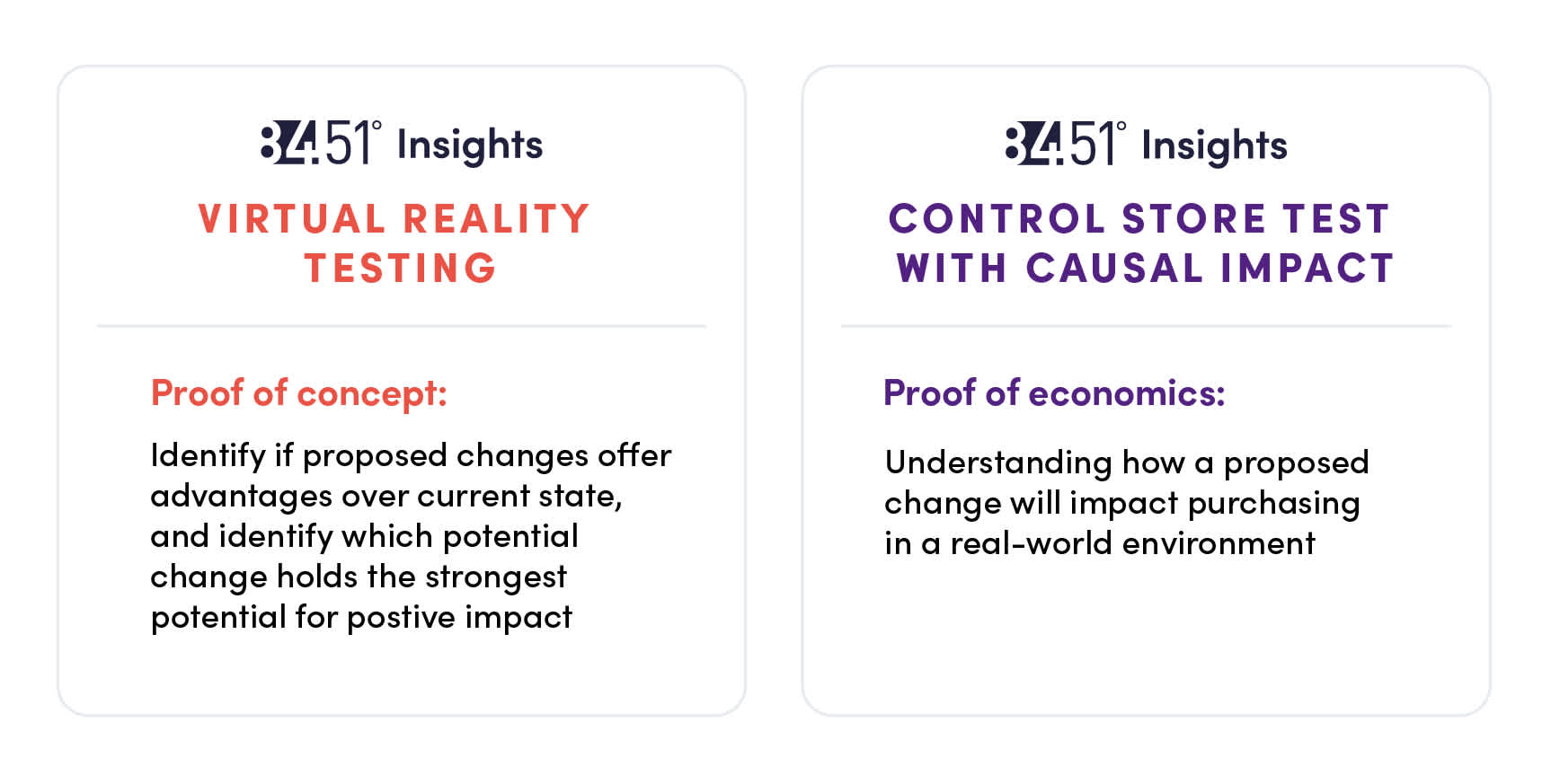
Virtual reality testing: Revolutionizing shopper insights

News about disruptive technologies such as the Internet of Things, blockchain, chatGPT, the metaverse (the list goes on) pop up all the time. What gets less attention are the incremental innovations that add up to transformative change. Consider virtual reality. While the jury is still out on the metaverse, virtual reality is already transforming brands’ and retailers’ abilities to design better customer experiences. In-store testing is a powerful tool for uncovering shopper insights that help consumer packaged goods (CPG)brands make informed decisions on aisle flow, package design, pack size, promotion strategies and myriad other factors that impact the customer relationship. But in-store testing has its limitations. Tweaking tests on the fly is difficult and so is testing early-phase ideas, for example.
Enter virtual reality testing. Simulation technology adds a crucial layer to testing environments, giving brands more flexibility and insights in measuring consumer responses to new concepts and ideas. Virtual reality isn’t just for gamers; virtual recreations of real-life settings and scenarios make ideal testing environments for many different industries, such as retail, consumer product manufacturing, and many others. And while people wearing headsets exploring virtual worlds like the metaverse are most often associated with virtual reality, there are various levels of VR experiences from non-immersive to semi-immersive and fully immersive.
When it comes to surveying a large group of consumers in totally immersive environments, there are significant barriers:
VR headsets cost hundreds to thousands of dollars, which limits their ubiquity
It’s difficult to recruit a representative group that is comfortable using VR headsets
If consumers need to show up at a location where the headsets are available, that further limits testing to just a few geographies
Due to these challenges, alternatives to fully immersive environments make sense. At 84.51°, for example, we use a virtual reality testing platform that is depicted on a computer screen. Without wearing a headset, consumers log into a simulated grocery store and get as close as possible to an actual grocery trip. They can wander the aisles and browse the shelves, including picking up items and reading the nutritional label, claims, ingredients and all other details. They can place the item back on the shelf or in a cart and see how many units they have purchased and how much they have spent in the simulation. This approach enables us to get a quantitative read on all of the behavior that occurs in the VR environment, as well as pair it with attitudinal research to better understand consumer preferences driving this behavior.
From a CPG’s perspective, VR testing can help get a foot in the door for an idea to be implemented in stores. Virtual reality testing is an excellent way to measure the impact of ideas or changes in a realistic and low-risk environment. These results can confirm or reject hypotheses and persuade retailers and suppliers to implement the most promising adjustments to the store. For instance, if a brand wanted to understand what the consumer response would be to rearranging the layout of their products, they could set up a simulated grocery aisle. Consumers participating in the virtual test would see either the existing layout or a new layout, shop the aisle, and then provide feedback. The brand could also add a findability component to further understand the shopper experience for particular products of interest. Creating the same testing scenario in real life would be more time-consuming and costly.
Brands can use virtual reality testing to answer a wide range of questions such as:
Just like in-store testing, virtual reality testing is not a silver bullet. The beauty of VR testing is that it allows brands to quickly test consumer responses to changes and ideas in near-real environments but it doesn’t replace the insights that actual in-store testing provides. For example, there are factors that shoppers encounter in real life—maneuvering a cart around other people, being distracted by their children—that a VR test might not accurately replicate.
Virtual reality testing is most effective when it is included with other testing strategies as an insights layer. Once several ideas or opportunities for improvement have been identified, VR testing is useful as a filter/precursor to store testing to prioritize which approach holds the strongest potential, and to understand if a change should be tested in a store environment. Taking a data- and insights-driven approach from start to finish enables brands to thoroughly vet changes before sharing them with customers for the most successful results.
Virtual reality testing will only get better at replicating the sensory shopping experience of a grocery store as time goes on. 3D interface design and other technology areas related to the metaverse continue to advance. Startups, for instance, are developing methods for adding scent to a virtual experience. At the same time, hardware costs are decreasing. Expect more companies and consumers to take the leap into VR [AP1] experiences in the near future, and the value and quantity of data that can be harnessed through research will continue to grow.
Especially in today’s hyperconnected, always-on world, consumer attention is at a premium. Brands don’t have the luxury of deploying promotions, displays and packaging that don’t resonate with customers. Experimenting with and testing changes in both virtual and physical environments is a smart way to uncover opportunities for increasing customer engagement and improving a product for greater success. Combining insights from both virtual and physical worlds enables brand leaders to meet customers where they are going and to implement the best strategies for their brands.
Whether it’s VR or in-store testing, we can help you identify the right application for your business needs.

Visit our knowledge hub
See what you can learn from our latest posts.




![[DO NOT DELETE] 8451-PR header 4000x2000 shutterstock 2146084959 po](https://images.ctfassets.net/c23k8ps4z1xm/CUmZcselsJUhnLz6rQuj2/0e48394e72423bb1073bf8bb6cf75974/8451-PR_header_4000x2000_shutterstock_2146084959_po.jpg?w=328&h=232&fit=fill)